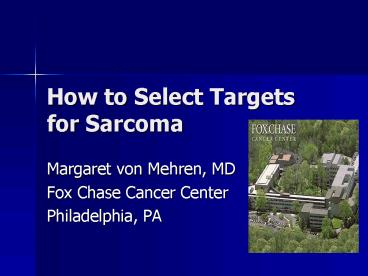How to Select Targets for Sarcoma PowerPoint PPT Presentation
1 / 29
Title: How to Select Targets for Sarcoma
1
How to Select Targets for Sarcoma
- Margaret von Mehren, MD
- Fox Chase Cancer Center
- Philadelphia, PA
2
Goal of Therapy
- Cure the patient
- Control the disease palliate or prevent symptoms
3
Traditional Therapies
Sarcoma
4
Traditional Therapies
Sarcoma
XRT
5
Traditional Therapies
TNT
Sarcoma
TNT
6
Traditional Therapies
TNT
TNT
Sarcoma
Sarcoma
XRT
7
Traditional Therapies
- Not tumor type specific
- Not tumor specific
- Limited therapeutic efficacy
8
GIST
- Prior to the 21st century, recurrent disease was
uniformly fatal
DeMatteo RP et al Human Pathology, 2002
9
Elevated levels of MDR proteins
Plaat BEC et al JCO, 2000
10
Identification of KIT Mutations in GIST
Hirota S, et al. Science, 1998
11
TKI therapy in GIST
- Imatinib
- Sunitinib
- Investigational agents
- Sorafenib
- Nilotinib
- Motesanib
- Dasatinib
12
Gastric GIST have a better prognosis than Small
Bowel GIST
Miettinen M and Lasota J. Arch Pathol Lab Med,
2006
13
Gene Expression based on Anatomic Site
Antonescu et al. Clin Cancer Res, 2004
14
Different Mutations require varying doses of
therapy
Debiec-Rychter et al. Eur J Cancer, 2006.
15
RTOG 0132 Phase II Study of Neoadjuvant
Imitanib for Primary or Recurrent Operable GIST
R E G I S T E R
Surgery
Biopsy
8 weeks imatinib
S C R E E N
PET Imaging
CD117 positive
Primary or recurrent operable GIST
Glut-4 Analysis
KIT, PDGFR Mutation analyses
Gene Profiling
16
Resistance
17
Resistance
Surgical specimen photo courtesy of JC Watson
18
Comparison of Cytogenetic Complexity in GIST and
Other Tumors
Leiomyo-sarcoma
GIST
NSCLC
Ovarian
OC and NSCLC karyotypes provided by J. Testa
19
The Lessons from GIST
- Target must be biologically relevant
- KIT/PDGFR are the oncogenic drivers of most GIST
- Treatment need not be cytotoxic for benefit
- Therapy must have limited toxicity because of
chronic use - Cancer cells evolve survival mechanisms to bypass
the inhibited target
20
Is having the Target Sufficient ?
- MPNST and Synovial Cell Sarcoma
- Express EGFR
- Gene amplification
- Model systems suggesting potential role in
oncogenesis in MPNST - Clinical trial using oral TKI against EGFR
revealed a median PFS of 2 months
KH Albritton et al, ASCO Abs 9518, 2006 JY Blay
et al, ASCO Abs 9517, 2006
21
Ecteinascidia turbinata
22
Trabectedin
Subunits AB are responsible for binding to the
minor groove of DNA
Highly reactive carbinolamine bond responsible
for alkylation
Subunit C is available for interaction with other
macromolecules
Used with permission from Pharma Mar USA, Inc.
23
Trabectedin
- Inhibits transcription of heat shock?inducible
genes - Interacts with the transcription-coupled
nucleotide excision repair system - Leads to the formation of DNA strand breaks, late
S and G2 phase cell cycle arrest, and p-53
independent apoptosis
Minuzzo M et al, PNAS 2000 Takebayashi Y et al.
Nat Med 2001 Erba E et al Eur J Cancer 2001
Martinez EJ, Corey EJ, Owa T Chem Biol 2001.
24
Trabectedin
- Trabectedin has resulted in tumor responses
particularly in liposarcomas - Myxoid-round cell liposarcomas commonly has a
translocation resulting in the FUS-CHOP or rarer
EWS-CHOP fusion proteins
25
Be Open to Surprises
Grosso F et al, ASCO 2007, ABS 10000
26
How do we know the target is relevant?
- Knowing the pathophysiology of a tumor
- Understanding what and how the drug targets
- Identifying the ideal patient population for each
therapy
27
What targets are out there?
28
Future Challenges
- Synthesizing data from genomic and proteomic
studies - Evaluating the biologic implications of findings
- Determining the drugability of a target
- Designing trials to efficiently test targeted
agents - Predicting resistance mechanisms
29
The Future
- Combination therapies
- Therapies targeting several pathways or one
pathway at different sites - Combining with standard chemotherapies
- Metastatic sarcomas becoming chronic diseases

